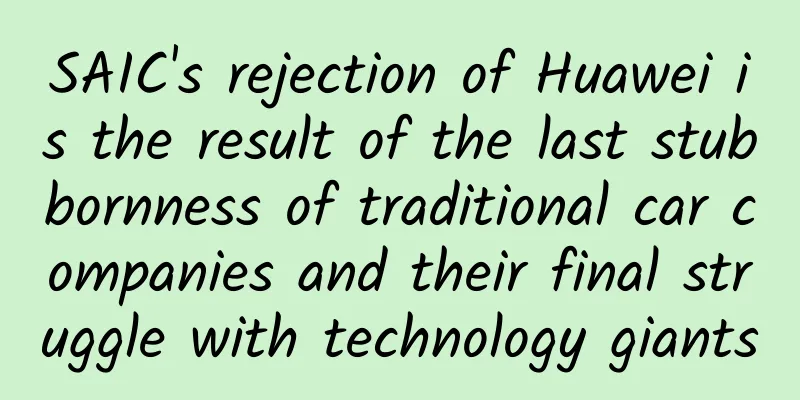SAIC's rejection of Huawei is the result of the last stubbornness of traditional car companies and their final struggle with technology giants

|
The incident of SAIC rejecting Huawei is still fermenting on the Internet. The discussion about "soul" and "body" has crossed the automotive industry and become a major debate about industrial competition and future travel. In many online comments, SAIC can be compared to Nokia ten years ago, which refused to embrace the Android system and eventually became the "old wave" that was washed up on the beach. What's more, SAIC, which rejected Huawei's autonomous driving technology but adopted Nvidia chips, was labeled a "comprador", pushing SAIC, a state-owned enterprise under the Shanghai State-owned Assets Supervision and Administration Commission, to the forefront of online public opinion. The game between SAIC and Huawei not only reflects the general anxiety of traditional car companies, but also reveals the reality that the confrontation between them and chip manufacturers, autonomous driving suppliers and other companies has entered a white-hot stage. Perhaps, it is not appropriate to compare car companies to Nokia, which is complacent, but "car companies are losing their souls" may not be a false proposition. So, today in this article, we will try to depict the changes taking place in the automotive industry today by dismantling the aborted cooperation between SAIC and Huawei. Huawei, the backbone of autonomous drivingThere is no doubt that car companies that choose to "lie down" in Huawei's arms have fully tasted the sweetness of being noticed by technology capital. On the stage of smart cars, as soon as Huawei appeared on the scene, it became the most powerful force in the whole arena. As early as April, Huawei released a real-life demonstration of the autonomous driving system of the BAIC Alpha S. In complex scenarios with mixed traffic of people and vehicles, the Alpha S performed extremely well and handled various emergencies on the scene with ease. Xiaokang Shares, which has deep cooperation with Huawei on autonomous driving, has become a dark horse in the stock market with a share price increase of 290.34%; and after the release of the BAIC Arcfox Alpha S HI version developed in cooperation with Huawei, the share price of BAIC Blue Valley increased from 8.51 yuan/share in April to 19.20 yuan/share in May, with a cumulative increase of nearly 130%. Huawei has a long-term vision for autonomous driving chips and technologies, and its technology is indeed impressive. In the technical framework it currently provides, the key chips are basically self-developed by Huawei. For example, the core chip of the intelligent cockpit of the HI version of Polar Fox is Kirin 990A, and the car is also the first mass-produced model equipped with LiDAR, which is Huawei's self-developed micro-rotating mirror 96-line medium- and long-range LiDAR. In addition, Huawei has also made a great ambition to reduce the cost of LiDAR to less than US$200. For this reason, SAIC Chairman Chen Hong’s words, “This cooperation with Huawei has made Huawei the soul and SAIC the body. SAIC cannot accept such a result because it wants to hold the 'soul' in its own hands”, made many netizens feel unacceptable. The subtext is - as a Chinese company, SAIC does not support Huawei at this moment. Does it have a problem with its conscience? So, in this case, why did SAIC reject Huawei so categorically, even if it wanted to cooperate with Huawei on a product line like Changan? Just like what Wang Xifeng said, “Bigness brings big difficulties.” SAIC, with a market value of RMB 200 billion, has its own long-term technology development route, as well as its own future and soul. Huawei's solution looks beautifulIn fact, SAIC is not opposed to cooperating with Internet industry giants in technological fields. As one of the earliest domestic automakers to start the new four modernizations, SAIC has long been engaged in in-depth cooperation with Alibaba on the Roewe brand. The smart cockpit concept and voice assistant, which still seem amazing today, appeared as early as 2016 on the Zebra Intelligent Driving System equipped in the Roewe RX5. However, although Huawei defines itself as a Tier 1 supplier, from the current perspective, Huawei's overall solution is obviously much stronger than that of suppliers such as Bosch. It is reported that currently, to cooperate with Huawei, one must accept the "Huawei whole bucket" from algorithms, chips to sub-power systems. Cars using Huawei's DriveOne solution must also migrate to Huawei in terms of overall architecture, because of the self-consistency and integration of Huawei's entire system, which makes it impossible for car companies to choose to use only part of Huawei's system services. Referring to the BAIC Arcfox series, the T version does not even have Huawei 5G, and even the versions below 300,000 yuan do not even have it as an optional feature. This means that after choosing Huawei's package solution, all high value-added software and hardware configurations have been contracted by Huawei, leaving SAIC with only the car shell and the non-electronic chassis, a veritable "shell". Correspondingly, Google provides Android Auto OS to third parties, but it does not affect the differentiation of car companies in hardware, chips and applications; manufacturers such as NVIDIA, Intel, and Horizon provide automotive chips and can even provide automakers with autonomous driving algorithms. Automakers can also choose to use the tool chain provided by the manufacturers to transplant their self-developed algorithms to the hardware platform. Therefore, we can see that Weilai and Xiaopeng, which use Nvidia chips, still decide to develop their own algorithms. We can also see that Tesla has left Nvidia behind and developed its own autonomous driving chips. Holding a part of what you think is your core competitiveness in your own hands is not only the trend of the industry, but also the foundation for your long-term and stable development. Even without talking about industry trends, the cost-effectiveness of Huawei's overall solution and its competitiveness in the industry are still questionable. The subsequent problems caused by this may erupt after mass-produced models are launched on the market. We can clearly see this from the price difference of nearly 140,000 yuan between the Huawei HI version of the BAIC Arcfox S and the ordinary version. From the agreement released by Huawei and Arcfox, BAIC only needs to ensure that Huawei can extract 10,000 yuan in profit from each car. Huawei's rotating chairman Xu Zhijun also emphasized this point at the Huawei Analyst Conference. It can be seen that the price difference between the two is almost entirely reflected in Huawei's autonomous driving hardware. Among them, the most expensive is obviously Huawei's self-developed LiDAR sensor. Moreover, according to reports, Huawei's self-developed 96-line LiDAR is still not available for installation. The current Polar Fox Hi version actually uses Shenzhen RoboSense's LiDAR M1. Once traditional car companies choose Huawei's solution, it not only means that the car purchase price has risen, but also means that the owner has to face the risk of repair. The three expensive laser radars installed in the front of the car may need to be disassembled to confirm its safety in the event of a minor rear-end collision. If the accident is more serious, the owner may need to pay a lot of repair fees. These are all issues that consumers have to consider when choosing the Huawei HI version of the Beijing Auto Arcfox S. In fact, it is precisely because of all the above reasons that traditional car companies are reluctant to choose Huawei as their autonomous driving technology supplier. First, the "soul" of autonomy has gone to others, and second, prices and output are not very controllable. Driving data, the “blood” of autonomous drivingHuawei's strength is also a core factor that large manufacturers consider when choosing to cooperate with it. Just from the current cooperation with Xiaokang and BAIC Blue Valley, we can see that the weight of Huawei's voice is actually far greater than that of ordinary suppliers. The model that SERES cooperated with Huawei is called "SERES Huawei Smart Selection SF5", and the model that BAIC BluePark cooperated with Huawei is named "BAIC Arcfox Alpha S Huawei HI Edition". As for Bosch, which is the No.1 among the traditional Tier 1 suppliers , we have never seen such strange names as "BMW X1 Bosch Hi Edition, Mercedes-Benz C Series Bosch Pro Edition". Unlike suppliers such as Bosch, which "make silent contributions" behind the scenes of car companies, Huawei is too strong in both brand and cooperation, and pursues a one-size-fits-all approach to solutions. Huawei is not the only tech giant facing this problem. Baidu Apollo and Google Waymo have little support from mainstream car manufacturers, and only third- and fourth-tier brands such as Arcfox and Seres choose to try them out of a desire to attract attention from technology capital. This is especially true for SAIC. In 2020, SAIC Motor sold 5.6 million vehicles, ranking first in China for 15 consecutive years. In addition, SAIC's overseas business is also outstanding, with 390,000 vehicles exported and sold overseas throughout the year, an increase of 11.3% year-on-year, and overseas sales exceeding one-third of the total overseas sales of Chinese automakers. At present, Huawei is still facing unfair treatment in overseas markets. Whether cooperation with Huawei will lead to certain overseas groups with ulterior motives taking advantage of the situation is also a problem that SAIC has to consider. With so many uncertain risks in cooperating with Huawei, automakers will naturally tend to cooperate with less powerful autonomous driving technology suppliers with no competitive risks. The reason why SAIC has the confidence to reject Huawei is that SAIC itself has already taken many substantial actions in autonomous driving technology. In 2017, SAIC Group reached a cooperation with the smart chip unicorn Horizon Robotics on the full range of Journey chips, and participated in Horizon Robotics' B round of financing in 2019, becoming its largest institutional shareholder. In 2020, SAIC Hongyan intelligent heavy-duty trucks opened up a complete control loop of the intelligent driving system through technologies such as lidar, machine vision, artificial intelligence, Beidou navigation, and 5G-V2X vehicle-to-vehicle communications, achieving L4 autonomous driving in specific scenarios in the port area, increasing the port's monthly cargo volume from 500 containers to 4,500 containers. In March this year, investors including SAIC Motors raised over $500 million in Series C funding for Momenta, a new company in autonomous driving technology. Compared with strong brands like Huawei, the autonomous driving technology "son" invested by car companies themselves will undoubtedly be more reliable to use. After the financing, Momenta also said frankly, "SAIC Motors is Momenta's golden seat customer." It is worth mentioning that Toyota, Bosch, Daimler and other industry giants also invested in Momenta together with SAIC. What they value and recognize is Momenta's "mass production data-driven" flywheel technology route, which is to use mass production data to drive algorithms and realize a feedback loop to bring about leapfrog development in autonomous driving. It is not difficult to find that the core of this route is the control and utilization of driving data, forming a positive cycle of "relying on technology to acquire customers, relying on customers to collect data, and relying on data to iterate technology", triggering the Matthew effect logic in the autonomous driving technology industry. If autonomous driving technology is the soul of the automotive industry, then data is its blood. Choosing Huawei's solution undoubtedly means giving up the initiative over driving data, which is unacceptable to large manufacturers. Even if they try to cooperate with Huawei through a brand line, it may be seen as "transfusing blood" to Huawei and cultivating competitors for themselves. NIO, Xpeng, Li Auto, and even Tesla in its early days, are all willing to use chips from suppliers, but they must develop their own algorithms as soon as possible. This involves deep considerations about the control over driving data. Traditional car manufacturers who insist on holding their "soul" in their own handsIt has to be admitted that compared with traditional car companies, autonomous driving and chip companies still have a real grasp of the "soul" of the "new four modernizations" era of automobiles. Not only Huawei, but capital's pursuit of autonomous driving technology and chip companies has already explained the problem. At present, no autonomous driving software and hardware company has the platform-level advantage that Android has in the mobile phone industry. Traditional car companies have not yet reached the day when Nokia did, and they still have a lot of spare energy and confidence. The difference between the algorithms developed by car companies and those of Huawei and Baidu is far from as huge as Symbian is to Android. Moreover, in the automotive field where safety and stability are more important, compared with the open Android system, the concept of iOS's hardware and software integration is more in line with the direction of industry development. From this perspective, leaving aside B-side autonomous driving manufacturers, Tesla is the only brand that has followed the industry path. The full-stack self-research from three-electric to chips to algorithms is the cornerstone of Tesla's position as the industry's top player. In contrast, in the era of electrification, the differentiation of automotive hardware has been leveled, just like the current Android phones, the hardware of each brand is almost on the same starting line. Because of this, traditional car companies like SAIC are gradually losing the advantages accumulated over the past few decades. What they have to do now is to run through the autonomous driving technology track at the fastest speed before their inherent advantages completely collapse, otherwise they will be abandoned by the times. At the just-concluded 2021 World Artificial Intelligence Conference, the once-prominent traditional car companies collectively lost their presence, and autonomous driving technology and chip manufacturers took their place as the protagonists, sending a clear and strong signal of market change. SAIC may not need Huawei, but Huawei is already at the table. "Holding the 'soul' in hand" is undoubtedly the right choice for traditional car companies. However, whether they can defeat a group of technology giants armed to the teeth in terms of "soul" depends on what Huang Jianxiang said: time is running out for traditional car companies. As a winner of Toutiao's Qingyun Plan and Baijiahao's Bai+ Plan, the 2019 Baidu Digital Author of the Year, the Baijiahao's Most Popular Author in the Technology Field, the 2019 Sogou Technology and Culture Author, and the 2021 Baijiahao Quarterly Influential Creator, he has won many awards, including the 2013 Sohu Best Industry Media Person, the 2015 China New Media Entrepreneurship Competition Beijing Third Place, the 2015 Guangmang Experience Award, the 2015 China New Media Entrepreneurship Competition Finals Third Place, and the 2018 Baidu Dynamic Annual Powerful Celebrity. |
>>: Manipulating elections, hijacking drones and cars, experts fear AI could do bad things
Recommend
What should the TV industry do in the future when it is stuck in the quagmire of closed-door development? The mobile phone industry has given the answer
Under heavy pressure, TV manufacturers have resor...
Modularity and AR phones: Did Lenovo bet on the right trend?
Not long ago, Lenovo held the Tech World Technolo...
JD.com’s fresh food category operation case analysis: How to build a store?
Sometimes, a store clearly has significant advant...
The strongest winter typhoon "Lei" may reach super typhoon level. Can it become the last typhoon to land in my country?
Typhoon Lei, the 22nd typhoon this year, has inte...
How much does it cost to join the Songyuan prenatal education mini program? What is the price for joining the Songyuan prenatal education mini program?
How much does it cost to join a prenatal educatio...
WeChat has undergone a huge change! It has been two days, but many people still don’t know...
After 6 years, WeChat's startup image has fin...
It’s endless. Seven more of its models were found to be involved in fraud. It’s time for Akio Toyoda to bow down again.
This is an era where boomerangs are flying everyw...
A brief discussion on Weibo marketing and promotion strategies!
Weibo may not bring direct sales, but it can subt...
Titles always lack appeal? Let’s try the 4 principles + 6 elements of this title
As we all know, the number of readers of public a...
How much does it cost to start Alibaba and how much does it cost to join Alibaba?
Some say they want money, some say they don’t. Is...
From 700 billion to 1 trillion: Apple's crisis of prosperity
Apple's market value has exceeded $700 billio...
This article teaches you how to use ByteDance search ads!
Starting from exploring search technology in 2016...
How to use ROI data to increase downloads and purchase conversions?
In the first half, traffic acquisition is used to...
Advertising cases in the automotive service industry!
In October this year, Shanghai's auto beauty ...
How was the deepest hole on Earth dug?
Author: Gui Youyu Reviewer: Zhou Yingcao, Chief E...









